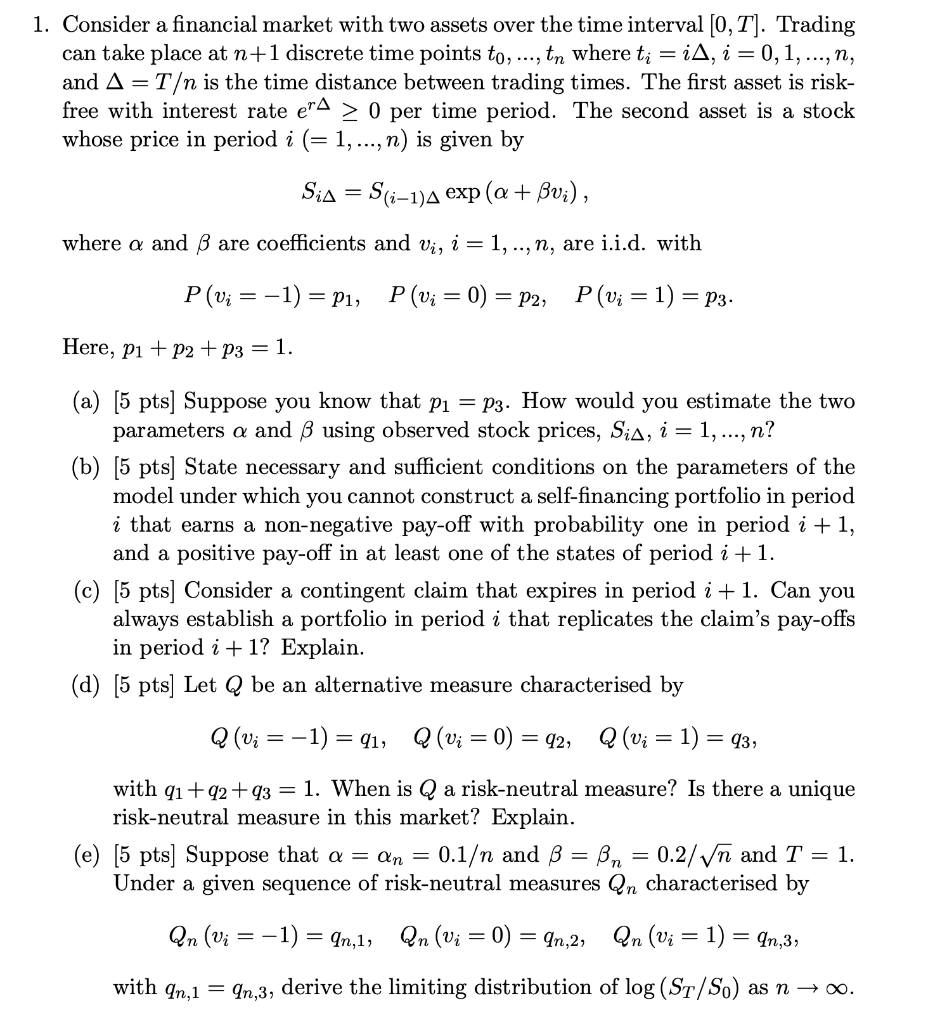
1. Consider a financial market with two assets over the time interval [0,T]. Trading can take place at n+1 discrete time points to , ..., tn where ti = iA, i = 0,1,..., n, and A=T is the time distance between trading times. The first asset is risk- free with interest rate era > 0 per time period. The second asset is a stock whose price in period i (= 1, ..., n) is given by Sia = S(i-1)A exp (a + Bvi), where a and B are coefficients and vi, i = 1, .., n, are i.i.d. with P(vi = -1) = P1, P(vi = 0) = P2, P(V; = 1) = P3. Here, pi + p2 + P3 = 1. (a) [5 pts) Suppose you know that p = P3. How would you estimate the two parameters a and B using observed stock prices, Sia, i = 1, ..., n? (b) [5 pts] State necessary and sufficient conditions on the parameters of the model under which you cannot construct a self-financing portfolio in period i that earns a non-negative pay-off with probability one in period i +1, and a positive pay-off in at least one of the states of period i +1. (c) [5 pts] Consider a contingent claim that expires in period i +1. Can you always establish a portfolio in period i that replicates the claim's pay-offs in period i +1? Explain. (d) [5 pts) Let Q be an alternative measure characterised by Q (V; = -1) = 91, Q(vi = 0) = 92, Q (vi = 1) = = 43, with q+92 +93 = 1. When is Q a risk-neutral measure? Is there a unique risk-neutral measure in this market? Explain. (e) [5 pts) Suppose that a = an = 0.1 and B = Bn = 0.2/ Vn and T = 1. Under a given sequence of risk-neutral measures Qn characterised by On (Vi -1) = an,1, Qn (vi = 0) = 9n,2, Qn (vi = 1) = qn,3, with qn,1 = 9n,3, derive the limiting distribution of log (St/So) as n +0. 1. Consider a financial market with two assets over the time interval [0,T]. Trading can take place at n+1 discrete time points to , ..., tn where ti = iA, i = 0,1,..., n, and A=T is the time distance between trading times. The first asset is risk- free with interest rate era > 0 per time period. The second asset is a stock whose price in period i (= 1, ..., n) is given by Sia = S(i-1)A exp (a + Bvi), where a and B are coefficients and vi, i = 1, .., n, are i.i.d. with P(vi = -1) = P1, P(vi = 0) = P2, P(V; = 1) = P3. Here, pi + p2 + P3 = 1. (a) [5 pts) Suppose you know that p = P3. How would you estimate the two parameters a and B using observed stock prices, Sia, i = 1, ..., n? (b) [5 pts] State necessary and sufficient conditions on the parameters of the model under which you cannot construct a self-financing portfolio in period i that earns a non-negative pay-off with probability one in period i +1, and a positive pay-off in at least one of the states of period i +1. (c) [5 pts] Consider a contingent claim that expires in period i +1. Can you always establish a portfolio in period i that replicates the claim's pay-offs in period i +1? Explain. (d) [5 pts) Let Q be an alternative measure characterised by Q (V; = -1) = 91, Q(vi = 0) = 92, Q (vi = 1) = = 43, with q+92 +93 = 1. When is Q a risk-neutral measure? Is there a unique risk-neutral measure in this market? Explain. (e) [5 pts) Suppose that a = an = 0.1 and B = Bn = 0.2/ Vn and T = 1. Under a given sequence of risk-neutral measures Qn characterised by On (Vi -1) = an,1, Qn (vi = 0) = 9n,2, Qn (vi = 1) = qn,3, with qn,1 = 9n,3, derive the limiting distribution of log (St/So) as n +0







